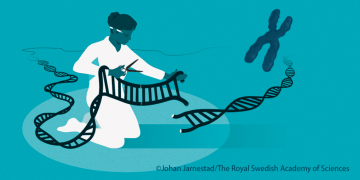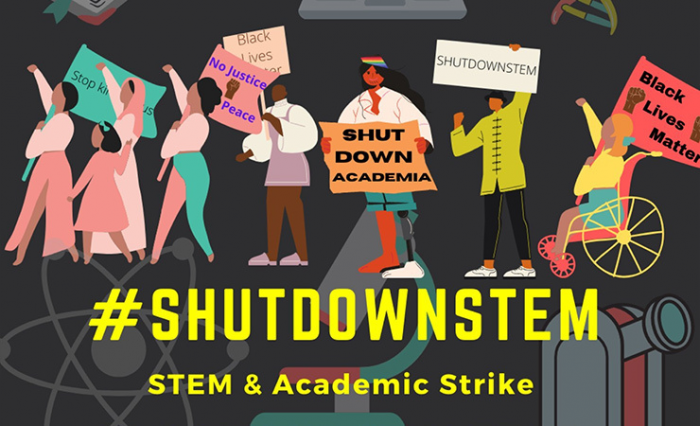 By Maria-Elizabeth Baeva, MSc student, Jefferies Lab
By Maria-Elizabeth Baeva, MSc student, Jefferies Lab
This is the fourth article in the Nobel Prize blog series.
Read the previous article: Nobel Prize Series Part 2: Who Lives, Who Dies, Who Tells Your Story.
The last decade has seen a resurgence in social justice movements in virtually all sectors: politics, sports, workplaces, entertainment and so on. Causes such as the Hockey Diversity Alliance and #OscarsSoWhite advocate for more representation and support for marginalized groups in their respective industries.
While it may feel like significant progress has been made given how terms such as “identity politics”, “representation”, “diversity”, “visibility” and “social justice” have become much more prevalent in our everyday lexicon, uplifting historically marginalized populations to more powerful and higher paying positions has been a glacial progress and seen minimal improvement at best. Additionally, while performative allyship looks good in a public relations campaign, true allyship involves not only acknowledgment of an unjust situation, but atonement as well. And it’s this second part that we are still struggling with, including the sciences.
As scientists, we pride ourselves in our discipline being objective and truth-seeking. Which is why topics of gender and racial inequality make us uncomfortable: it’s difficult to come to terms with the fact that this “rational” profession is still subject to irrational prejudices. The Nobel Prize is an institution unfortunately not exempt from discriminatory norms. Although some improvement has been made since the establishment of the prize, there is still much work to be done. While we should celebrate progress (for example, Emmanuelle Charpentier and Jennifer A. Doudna winning the Nobel Prize in Chemistry 2020 for their innovations with CRISPR1), it’s a sobering reminder that this is clearly not the norm.

Like “genetic scissors”, Emmanuelle Charpentier and Jennifer A. Doudna’s innovations with CRISPR can “snip” DNA. Image credit: © Johan Jarnestad/The Royal Swedish Academy of Sciences.
In the tradition of Buzzfeed list articles, I will now present 5 sad statistics about the Nobel Prize when it comes to race and gender2,3:
- As of 2020, there has never been a Black Nobel Laureate for one of the science awards.
- As of 2020, 3.7% of Nobel Laureates in sciences are women.
- In 2018, Canadian physicist Donna Strickland was the first woman to win the Nobel Prize in physics in 55 years.
- In 2013, 82% of all Nobel laureates were from Western Europe, North America, Australia or New Zealand.
- In 2013, all of Asia, Africa, Latin America and the Middle East had a combined 104 Nobel laureates or 10% of Nobel laureates despite holding 81% of the world’s population.
But these statistics are not unique to the Nobel Prize and reflect the inequalities that still face the scientific community today. The issue of bias and discrimination is two-fold: they impact opportunities to access and participate in the education and resources necessary for scientific achievement and the nomination and selection process in the recognition of achievements.
The Nobel Prize committee has been attempting to address the second issue from a top-down approach. But only within the last five years have nominators been told to consider diversity in gender, geography and topic when deciding who to nominate. The committee has also selected more women to become nominators. Yet, it is difficult to measure how much progress has or will occur because nominations remain confidential for 50 years.
But are incremental institutional policy changes working so far? Not really. Göran Hansson, general secretary of the Royal Swedish Academy of Sciences (the body responsible for giving the Nobel Prize in Chemistry and Physics) said in an interview in 20194: “Women are no more likely to nominate women than men are, that’s the conclusion”. This bias in favour of men across genders has been known for many years5.
In another part of the same interview, Hansson had the following comment about diversity and the Nobel Prize:
But we have a balance to strike here. Alfred Nobel explicitly stated that we should not consider nationality when we award the prize. He wrote in his will that the most worthy individual shall receive the prize, irrespective of whether they are Scandinavian or not. So, we will never introduce quotas for nations, ethnicity or, for that matter, gender. It’s important that the individual who receives the Nobel prize gets it because she or he is the most worthy recipient. And there should never be any question about that.
This exchange reveals an all-too familiar attitude and fundamental misunderstanding of how we repair injustice. It’s not enough to say that moving forward, we will not see color or gender. In order to atone for the decades and centuries of exclusion and discrimination, it’s not enough to say we will now all start at the same starting line, because some are starting 100 meters behind with a broken foot. The Nobel Prize committee needs to decide: if they are genuinely interest in pursuing the noble quest for recognizing human contributions for the ultimate betterment of society, then justice and reparations cannot be sidelined, especially given that science itself was used for centuries to promote racist and sexist attitudes and behaviours6. Radical reforms are necessary.

An international academic strike titled #ShutDownSTEM day took place on June 10, 2020 as an opportunity to reflect on anti-Black racism in academia and STEM and to support BLM protests that restarted in the summer of 2020 after the murder of George Floyd. Image credit.
The most shocking part of researching this topic was discovering that while many articles correctly point out the biases present in the Nobel Prize7, there are relatively fewer offering pragmatic solutions or alternatives8. I think now that we are critically evaluating previously accepted dogmas and traditions, this is an excellent time to start funding research into effective policy changes to make the Nobel Prizes more equitable. We may eventually come across the uncomfortable notion that perhaps the Nobel Prizes, at least in its current state, does in fact cause harm. But it’s not too late; change for the better is still possible. It begins with introspection and acknowledgement and ends with retributive justice and a commitment to promoting a fair society.
What can we do in the meantime? The articles previously mentioned offer a few suggestions, such as requiring that nominators nominate more than one scientist, and increasing transparency about the demographics of nominators and nominees. We have the ability to make a least some positive changes right away.
At the end of the day, is it fair to ask one organization to lead the charge in establishing gender and racial equality in the scientific community? Some may disagree, but in our final segment, when we discuss the effects of winning a Nobel Prize on a recipient, this argument may not seem too far-fetched.
For further reading, please read this excellent piece from fellow CBR member, Bronwyn Lyons, on gender disparity in STEM and the Nobel Prizes9.
Read the series finale: The Nobel Prize Series Part 4: A Grand Finale
Sources:
- Nobel Media AB 2020. The Nobel Prize in Chemistry 2020. NobelPrize.org. Accessed October 27th 2020. https://www.nobelprize.org/prizes/chemistry/2020/summary/
- Perry MJ. (2013, October 15th) The history of the Nobel prize in maps and charts, and it’s not fair – there’s a lot of inequality in the global distribution. American Enterprise Institute. Accessed October 27th 2020. https://www.aei.org/carpe-diem/the-history-of-the-nobel-prize-in-maps-and-charts-and-its-not-fair-theres-a-lot-of-inequality-in-the-global-distribution/
- Wikipedia. (2020, October 12th). List of female Nobel laureates. Wikipedia. Accessed October 27th 2020. https://en.wikipedia.org/wiki/List_of_female_Nobel_laureates
- Gibney E. (2019, October 4th). ‘More women are being nominated’: Nobel academy head discusses diversity. Nature News Q&A. Accessed October 27th 2020. https://www.nature.com/articles/d41586-019-02988-5 doi: https://doi.org/10.1038/d41586-019-02988-5
- United Nations Development Programme. (2020). Tackling Social Norms: A game changer for gender inequalities. 2020 Human Development Perspectives Report. Accessed October 27th 2020. http://hdr.undp.org/sites/default/files/hd_perspectives_gsni.pdf
- Clough, S. and Orozco, J. (2016). Scientific Sexism and Racism. In The Wiley Blackwell Encyclopedia of Gender and Sexuality Studies (eds A. Wong, M. Wickramasinghe, r. hoogland and N.A. Naples). doi:10.1002/9781118663219.wbegss315
- Frazee G. (2019, October 14th). Why the 2019 Nobel Prizes in STEM struggled with diversity. PBS News Hour. Accessed October 27th 2020. https://www.pbs.org/newshour/economy/making-sense/why-the-nobel-prizes-in-science-are-struggling-with-diversity
- Gibney E. (2018, October 2nd). What the Nobels are — and aren’t — doing to encourage diversity. Nature News. Accessed October 27th 2020. https://www.nature.com/articles/d41586-018-06879-z
- Lyons B. (2019, August 19th). A Plug for the Leaky Pipeline. Center for Blood Research Magazine. Accessed October 27th 2020. https://cbr.ubc.ca/a-plug-for-the-leaky-pipeline/


